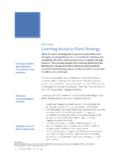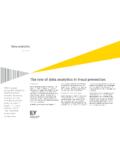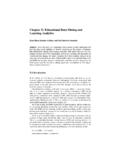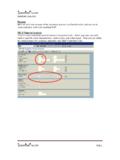Transcription of Simple Analytics of the Government Expenditure …
1 Simple Analytics of the Government ExpenditureMultiplier Michael WoodfordColumbia UniversityJune 13, 2010 AbstractThis paper explains the key factors that determine the output multiplierof Government purchases in New Keynesian models, through a series of simpleexamples that can be solved analytically. Sticky prices or wages allow forlarger multipliers than in a neoclassical model, though the size of the multiplierdepends crucially on the monetary policy response. A multiplier well in excessof 1 is possible when monetary policy is constrained by the zero lower bound,and in this case welfare increases if Government purchases expand to partiallyfill the output gap that arises from the inability to lower interest rates. Prepared for the session Fiscal Stabilization Policy at the meetings of the Allied Social ScienceAssociations, Atlanta, Georgia, January 3-5, 2010.
2 I would like to thank Marco Bassetto, PierpaoloBenigno, Sergio de Ferra, Gauti Eggertsson, Marty Eichenbaum, Bob Gordon, Bob Hall, John Taylorand Volker Wieland for helpful discussions, Dmitriy Sergeyev and Luminita Stevens for researchassistance, and the National Science Foundation for research support under grant recent worldwide economic crisis has brought renewed attention to the ques-tion of the usefulness of Government spending as a way of stimulating aggregateeconomic activity and employment during a slump. Interest in fiscal stimulus as anoption has been greatly increased by the fact that in many countries by the endof 2008, the short-term nominal interest rate used as the main operating target formonetary policy had reached zero or at any rate, some very low value regarded asan effective lower bound by the central bank in question so that further interestrate cuts were no longer available to stave off spiraling unemployment and fears ofeconomic collapse.
3 Increases in Government spending were at least a dimension onwhich it was possible for governments to do more but how effective should this beexpected to be as a remedy?Much public discussion of this issue has been based on old-fashioned models (bothKeynesian and anti-Keynesian) that take little account of the role of intertemporaloptimization and expectations in the determination of aggregate economic present paper instead reviews the implications for this question of the kind of NewKeynesian DSGE models that are now commonly used in monetary policy focuses on one specific question of current interest: the determinants of the size ofthe effect on aggregate output of an increase in Government purchases, or what hasbeen known since Keynes (1936) as the Government Expenditure multiplier . I discuss this issue in the context of a series of models that are each Simple enoughfor the effects to be computed analytically, so that the consequences of parametervariation for the quantitative results will be completely clear.
4 It is hoped that theeconomic mechanisms behind the various results will be fairly transparent as well. Ialso restrict my attention to policy experiments that are defined in such a way thatthe time path of the increase in output has the same shape as the time path of theincrease in Government purchases, so that there is a clear meaning to the calculationof a multiplier (though more generally this need not be the case). These modelsare too Simple to be taken seriously as the basis for quantitative estimates of theeffects of some actually contemplated policy change; nonetheless, I believe that themechanisms displayed in these Simple examples explain many of the numerical resultsobtained by a variety of recent authors in the context of empirical New KeynesianDSGE models,1and the simpler analysis here may be of pedagogical begin be reviewing in section 1 the neoclassical benchmark under which in-1 See, for example, comments below on the studies of Christianoet al.
5 (2009), Coganet al.(2010),Erceg and Lind e (2009), and Uhlig (2010).1tertemporal optimization should result in a multiplier less than 1. Section 2 thenshows that in Simple New Keynesian models, if monetary policy maintains a constantreal interest rate, the multiplier is instead equal to 1. Section 3 shows that undermore realistic assumptions about monetary policy under normal circumstances, themultiplier will be less than 1, because real interest rates will increase; but section 4shows that when the zero lower bound is a binding constraint on monetary policy,the multiplier is instead greater than 1, because fiscal expansion should cause the realinterest rate to fall. Section 5 considers the welfare effects of Government purchasesin these various case, while section 6 briefly discusses the consequences of allowingfor tax distortions. Section 7 summarizes the paper s A Neoclassical BenchmarkI shall begin by reviewing the argument that Government purchases necessarily crowdout private Expenditure (at least to some extent), according to a neoclassical general-equilibrium model in which wages and prices are both assumed to be perfectly provides a useful benchmark, relative to which I shall wish to discuss the con-sequences of allowing for wage or price rigidity.
6 I shall confine my analysis here toa relatively special case of the neoclassical model, first analyzed by Barro and King(1984), though the result that the multiplier for Government purchases is less thanone does not require such special A Competitive EconomyConsider an economy made up of a large number of identical, infinite-lived households,each of which seeks to maximize t=0 t[u(Ct) v(Ht)],( )whereCtis the quantity consumed in periodtof the economy s single producedgood,Htis hours of labor supplied in periodt, the period utility functions satisfyu >0, u <0, v >0, v >0,and the discount factor satisfies 0< < good2 More general expositions of the neoclassical theory include Barro (1989), Aiyagariet al.(1992),and Baxter and King (1993).2is produced using a production technology yielding outputYt=f(Ht),( )wheref >0, f < output is consumed either by households or by thegovernment, so that in equilibriumYt=Ct+Gt( )each period.
7 I shall begin by considering the perfect foresight equilibrium of a purelydeterministic economy; the alternative fiscal policies considered will correspond toalternative deterministic sequences for the path of Government purchases{Gt}. I shallalso simplify (until section 6) by assuming that Government purchases are financedthrough lump-sum taxation; a change in the path of Government purchases is assumedto imply a change in the path of tax collections so as to maintain intertemporalgovernment solvency. (The exact timing of the path of tax collections is irrelevant inthe case of lump-sum taxes, in accordance with the standard argument for Ricardianequivalence. )One of the requirements for competitive equilibrium in this model is that in anyperiod,v (Ht)u (Ct)=WtPt.( )This is a requirement for optimal labor supply by the representative household, whereWtis the nominal wage in periodt, andPtis the price of the good.
8 Another require-ment is thatf (Ht) =WtPt.( )This is a requirement for profit-maximizing labor demand by the representative order for these conditions to simultaneously be true, one must havev /u =f ateach point in ( ) to substitute forHtand ( ) to substitute forCtin this relation, oneobtains an equilibrium conditionu (Yt Gt) = v (Yt)( )in whichYtis the only endogenous variable. Here v(Y) v(f 1(Y)) is the disutilityto the representative household of supplying a quantity of outputY, so that v =3v /f .(Note that our previous assumptions imply that v >0, v >0.) This is alsoobviously the first-order condition for the planning problem of choosingYtmaximizeutility, given preferences, technology, and the level of Government purchases; thusthis equilibrium condition reflects the familiar result that competitive equilibriummaximizes the welfare of the representative household (in the case that thereisarepresentative household).
9 Condition ( ) can be solved for equilibrium outputYtas a function ofGt. Dif-ferentiation of the function implicitly defined by ( ) yields a formula for the mul-tiplier ,dYdG= u u+ v,( )where u>0 is the negative of the elasticity ofu and v>0 is the elasticity of v with respect to increases follows that the multiplier is positive, butnecessarily less than 1. This means that private Expenditure (here, entirely modeledas non-durable consumer Expenditure ) is necessarily crowded out, at least partially, bygovernment purchases. In the case that the degree of intertemporal substitutability ofprivate Expenditure is high (so that uis small), while the marginal cost of employingadditional resources in production is sharply rising (that vis large), the multipliermay be only a small fraction of Monopolistic CompetitionThe mere existence of some degree of market power in either product or labor marketsdoes not much change this result.
10 Suppose, for example, that instead of a singlegood there are a large number of differentiated goods, each with a single monopolyproducer; and, as in the familiar Dixit-Stiglitz model of monopolistic competition, letus suppose that the representative household s preferences are again of the form ( ),but thatCtis now a constant-elasticity-of-substitution aggregate of the household spurchases of each of the differentiated goods,Ct [ 10ct(i) 1 di] 1,( )wherect(i) is the quantity purchased of goodi, and >1 is the elasticity of sub-stitution among differentiated goods. Let us suppose for simplicity that each good3 That is, u Y u /u , v Y v / v .4is produced using a common production function of the form ( ), with a singlehomogeneous labor input used in producing all goods. In this model, each producerwill face a downward-sloping demand curve for its product, with elasticity ; profitmaximization will then require not production to the point where marginal cost isequal to the price for which it sells its good, but only to the point at which the priceof goodiis equal to times marginal cost, where the desired markup factor is givenby 1>1.
















